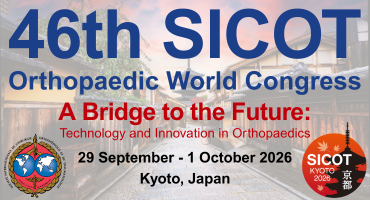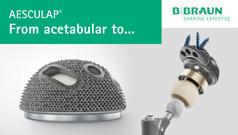Spine
SICOT Associate Member & SICOT Newsletter Editorial Board Member - London, United Kindgom
Questions
The Thoracolumbar Injury Classification and Severity (TLICS) Score includes all of the following except:
Fracture mechanism
Neurological involvement
ASIA grading
Posterior ligamentous complex integrity
Fracture morphology
According to the TLICS Score, a definitive indication for surgery would be:
Score 0-1
Score 2-3
Score 3-4
Score 4-5
Score 5-6
Which of the following spinal cord injuries carries the best prognosis?
Central cord syndrome
Anterior cord syndrome
Complete spinal cord injury
Brown Sequard syndrome
Single root lesions
Which of the following spinal cord injuries carries the worst prognosis?
Central cord syndrome
Anterior cord syndrome
Complete spinal cord injury
Brown Sequard syndrome
Single root lesions
Which of the following spinal cord injuries is the most common and is often seen in patients with pre-existing cervical spondylosis?
Central cord syndrome
Anterior cord syndrome
Complete spinal cord injury
Brown Sequard syndrome
Single root lesions
According to the Frankel classification, Grade D correlates with:
Normal function (grade 5/5)
Sensory function only below injury level
Complete paralysis
Incomplete motor function (grade 1-2/5) below injury level
Fair to good motor function (grade 3-4/5) below injury level
Degenerative spondylolisthesis is more common in all of the following cases except:
African Americans
Diabetics
> 40 years
L5/S1 level
Females
The lateral spinothalamic tract include nerve fibers transmitting:
Light touch to the ipsilateral side of the body
Pain and temperature to the contralateral side of the body
Light touch to the contralateral side of the body
Pain and temperature to the ipsilateral side of the body
Position and fine touch to the ipsilateral side of the body
According to Anderson and D’Alonzo classification of odontoid peg fractures, which of the following types carry the highest risk of nonunion?
Type I
Type II
Type III
Type IV
Type V
During the anterior approach to the cervical spine, all of the following structures are normally encountered except:
Carotid sheath
Superior and inferior thyroid arteries
Sternocleidomastoid and strap muscles
Vertebral artery
Pretracheal and prevertebral fascia
Answers
c
Discussion: ASIA grading system is used to define and describe the extent and severity of spinal cord injury and help determine future rehabilitation and recovery needs. It is based on motor and sensory testing and is ideally completed within 72 hours after the initial injury.
Reference: Vaccaro AR, Lehman RA Jr, Hurlbert RJ, et al. A new classification of thoracolumbar injuries: the importance of injury morphology, the integrity of the posterior ligamentous complex, and neurologic status. Spine. 2005 Oct 15; 30(20): 2325-33e
Discussion: Score 0-3 nonoperative treatment. Score 4 either nonoperative or operative treatment, according to qualifiers such as comorbid medical conditions or other injuries. Score > 4 operative treatment
Reference: Vaccaro AR, Lehman RA Jr, Hurlbert RJ, et al. A new classification of thoracolumbar injuries: the importance of injury morphology, the integrity of the posterior ligamentous complex, and neurologic status. Spine. 2005 Oct 15; 30(20): 2325-33d
Discussion: Brown Sequard syndrome damages half of the cord, causing ipsilateral motor loss, position/propioception loss and contralateral pain, and temperature loss (usually two levels below the insult). This injury, usually the result of penetrating trauma carries the best prognosis.
Reference: Review of Orthopaedics, Millerb
Discussion: Anterior cord syndrome is the second most common injury, in which the damage is primarily in the anterior two-thirds of the cord, sparing the posterior columns (propioception and vibration sensation). These patients demonstrate greater motor loss in the legs than in the arms. CT scan may demonstrate bony fragments compressing the anterior cord. The anterior cord syndrome carries the worse prognosis.
Reference: Review of Orthopaedics, Millera
Discussion: Central cord syndrome is the most common and is often seen in patients with pre-existing cervical spondylosis who sustain a hyperextension injury. The cord is anteriorly compressed by Osteophytes and posteriorly by the infolded ligamentum flavum. The cord is injured in the central gray matter, which results in proportionately greater loss of motor function to the upper extremities than to the lower extremities, with variable sensory sparing.
Reference: Review of Orthopaedics, Millere
Discussion: Frankel classification is useful when considering functional recovery from spinal cord injury and includes the following grades:
A: Complete paralysis
B: Sensory function only below injury level
C: Incomplete motor function (grade 1-2/5) below injury level
D: Fair to good motor function (grade 3-4/5) below injury level
E: Normal function (grade 5/5)
Reference: Review of Orthopaedics, Millerd
Discussion: It is most common with L4/5 level
Reference: Review of Orthopaedics, Millerb
Discussion:
Anterior corticospinal tract → contralateral skilled movement
Lateral corticospinal tract → ipsilateral skilled movement
Anterior spinothalamic tract → contralateral light touch
Lateral spinothalamic tract → contralateral pain and temperature
Fasciculus gracilis → ipsilateral position/fine touch
Reference: Campbell’s Operative Orthopaedicsb
Discussion: Type I fractures are uncommon, and even if nonunion occurs after inadequate immobilization, no instability results. Type II are the most common, and Anderson and D’Alonzo reported 36% nonunion rate for displaced and non-displaced type II fractures. Type III fractures have a large cancellous base and heal without surgery in 90% of cases. There is no type IV or V in Anderson and D’Alonzo classification.
Reference: Campbell’s Operative Orthopaedicsd
Discussion: The vertebral artery which lies in the costotransverse foramen on the lateral portion of the transverse processes should not be visible during the approach unless the plane of operation strays well away from the midline.
Reference: Hoppenfeld Surgical Exposures in Orthopaedics

















